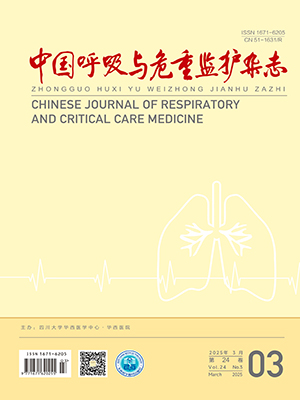| 1. |
Hogerwerf L, De Gier B, Baan B, et al. Chlamydia psittaci (psittacosis) as a cause of community-acquired pneumonia: a systematic review and meta-analysis. Epidemiol Infect, 2017, 145(15): 3096-3105.
|
| 2. |
Dai JM, Lian X, Mo JF, et al. Case report: a clinical case study of six patients with Chlamydia psittaci pneumonia. Front Cell Infect Microbiol, 2023, 13: 1084882.
|
| 3. |
中华医学会呼吸病学分会. 下呼吸道感染宏基因组二代测序报告临床解读路径专家共识. 中华结核和呼吸杂志, 2023, 46(4): 322-335.
|
| 4. |
中华医学会呼吸病学分会. 中国成人社区获得性肺炎诊断和治疗指南(2016年版). 中华结核和呼吸杂志, 2016, 39(4): 253-279.
|
| 5. |
Ni Y, Zhong H, Gu Y, et al. Clinical features, treatment, and outcome of psittacosis pneumonia: a multicenter study. Open Forum Infect Dis, 2023, 10(2): ofac518.
|
| 6. |
Zhang Z, Zhou H, Cao H, et al. Human-to-human transmission of Chlamydia psittaci in China, 2020: an epidemiological and aetiological investigation. Lancet Microbe, 2022, 3(7): e512-e520.
|
| 7. |
Kozuki E, Arima Y, Matsui T, et al. Human psittacosis in Japan: notification trends and differences in infection source and age distribution by gender, 2007 to 2016. Ann Epidemiol, 2020, 44: 60-63 .
|
| 8. |
沈凌, 田贤江, 梁荣章, 等. 鹦鹉热衣原体肺炎48例临床特征分析. 中华结核和呼吸杂志, 2021, 44(10): 886-891.
|
| 9. |
Li Y, Lin F, Li W, et al. Comparison of clinical, laboratory and radiological characteristics between Chlamydia psittaci and adenovirus pneumonias: a multicenter retrospective study. Int J Infect Dis, 2023, 126: 114-124.
|
| 10. |
Fang C, Xu L, Lu J, et al. Clinical characteristics of Chlamydia psittaci pneumonia confirmed by metagenomic next-generation sequencing. Clin Lab, 2022, 68(11): .
|
| 11. |
Yang M, Yang DH, Yang H, et al. Clinical characteristics of Chlamydia psittaci pneumonia infection in central south China. Infect Dis Ther, 2022, 11(4): 1631-1647.
|
| 12. |
Zhu N, Zhou D, Yuan R, et al. Identification and comparison of Chlamydia psittaci, Legionella and Mycoplasma pneumonia infection. Clin Respir J, 2023, 17(3): 384-393.
|
| 13. |
Alzoubi O, Khanfar A. Association between neutrophil to lymphocyte ratio and mortality among community acquired pneumonia patients: a meta-analysis. Monaldi Arch Chest Dis, 2021, 92(3): .
|
| 14. |
Jurisic V, Radenkovic S, Konjevic G. The actual role of LDH as tumor marker, biochemical and clinical aspects. Adv Exp Med Biol, 2015, 867: 115-124.
|
| 15. |
Duan Z, Gao Y, Liu B, et al. The application value of metagenomic and whole-genome capture next-generation sequencing in the diagnosis and epidemiological analysis of psittacosis. Front Cell Infect Microbiol, 2022, 12: 872899.
|
| 16. |
Tang J, Tan W, Luo L, et al. Application of metagenomic next-generation sequencing in the diagnosis of pneumonia caused by Chlamydia psittaci. Microbiol Spectr, 2022, 10(4): e0238421.
|
| 17. |
Wu HH, Feng LF, Fang SY. Application of metagenomic next-generation sequencing in the diagnosis of severe pneumonia caused by Chlamydia psittaci. BMC Pulm Med, 2021, 21(1): 300.
|
| 18. |
北京医学会检验医学分会. 重症社区获得性肺炎病原微生物实验室诊断专家共识. 中华医学杂志, 2020, 100(19): 1459-1464.
|
| 19. |
He LJ, Yang HZ, Liu SG, et al. Physiological analysis of severe chlamydia psittaci pneumonia and clinical diagnosis after doxycycline-based treatment. Front Physiol, 2023, 14: 1132724.
|
| 20. |
朱榕生, 罗汝斌, 王选锭. 鹦鹉热衣原体致重症社区获得性肺炎一例. 中华结核和呼吸杂志, 2019, 42(7): 548-551.
|
| 21. |
Cui Z, Meng L. Psittacosis pneumonia: diagnosis, treatment and interhuman transmission. Int J Gen Med, 2023, 16: 1-6.
|
| 22. |
Dai N, Li Q, Geng J, et al. Severe pneumonia caused by Chlamydia psittaci: report of two cases and literature review. J Infect Dev Ctries, 2022, 16(6): 1101-1112.
|




